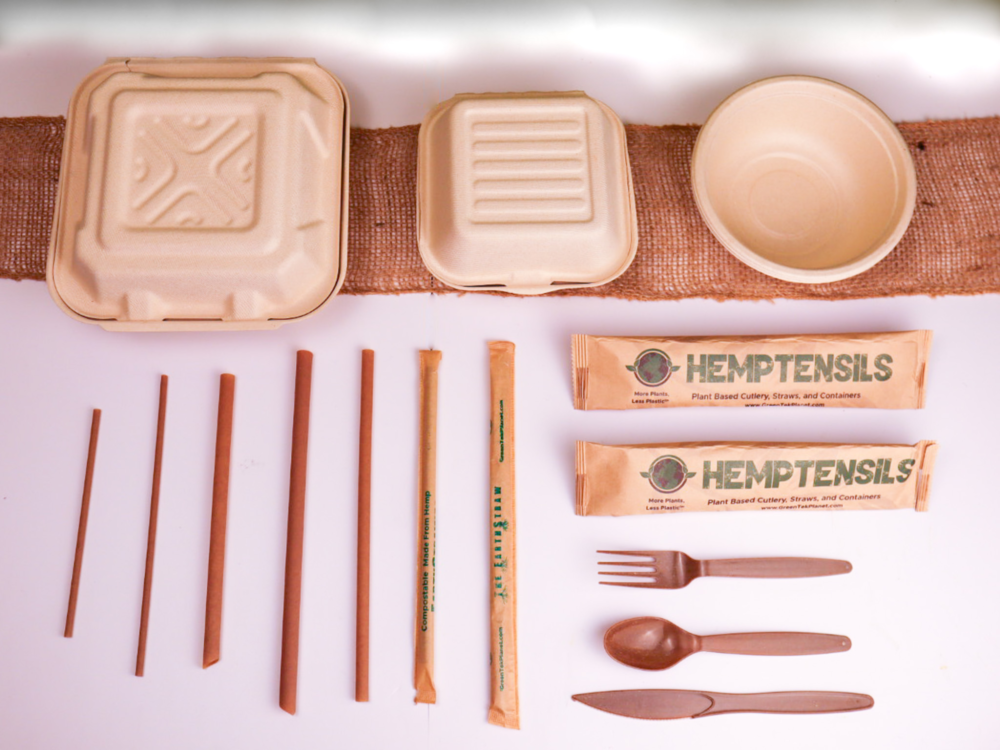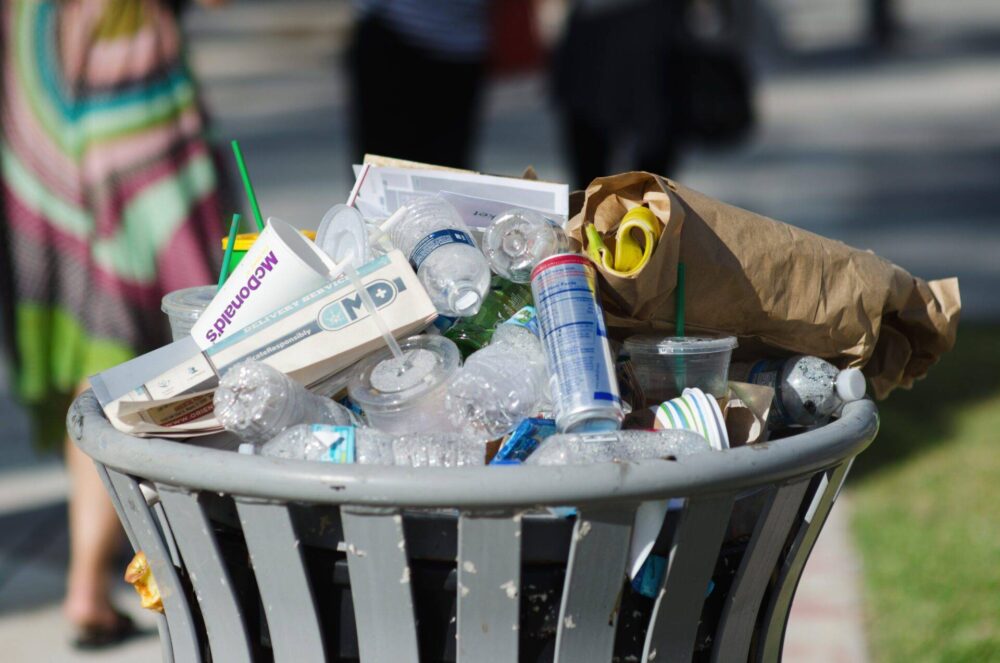According to recent studies, 97% of small business owners want to start environmentally responsible initiatives, while 78% of consumers are more likely to patronize businesses that have environmentally friendly products. For businesses looking to survive in this economy, the value of increasing their traffic cannot be understated. So how do we achieve this? Read on to learn some of the key ways brands are meeting consumer demands with the most cost-competitive, environmentally-sound practices of the moment.
The massive consumption of disposables means restaurants have a profound impact on the environment; increasingly, customers want to give their business to restaurateurs that are aware and are taking the necessary steps to reduce their footprint. Stats show restaurants account for 20% of total U.S. pollution through energy consumption, food, water and chemical waste, and even emissions of aerosols. To date, 44% of plastic discarded in and around bodies of water are from take-out packaging and supplies.
Balancing the growing demand for environmental responsibility on one hand, and keeping carbon emissions as low as possible for a fully-running restaurant with a myriad of other expenses on the other is undeniably challenging. How can businesses work towards these objectives without compromising their budget or their customers’ experience?
Restaurant sustainability practices that drive traffic, reduce your carbon footprint and increase earnings:
-
Reduce Food Waste
Every year, America produces approximately $160 billion in food waste. About ⅓ of food worldwide goes to waste, resulting in 10% of greenhouse gas emissions. An obvious but under-utilized solution is in food waste reduction programs that are beneficial to the planet as well as a restaurant’s bottom line–spending $1 on food waste reduction has yielded a $14 return on investment for businesses based on recent case studies.
How so? For one, donating food (an unmerited taboo due to the perceived legal risk) can play a substantial role in cost reduction and overall good. Good Samaritan Laws ensure that as long as this food was not donated with the intention of harm, lawsuits can not be pursued, as history has proven no one has ever been sued for donated food. Realizing this reality, technology platforms like Copia have helped businesses with safe food waste management. Copia works with foodservice providers to safely donate their excess food to local nonprofits and provides powerful data analytics to track food surplus trends, thereby empowering businesses to make optimal purchasing decisions that will match supply and demand. In addition, their analytics tool helps businesses quantify the socio-environmental impact of their donations so they can share their efforts with their customers and the IRS for tax obligations–increasing your earnings.
Restaurants can also reduce food waste by seasonally rotating their menu offerings. That way restaurants can accommodate ingredients with their respective growing seasons. If substantial waste from customers is common, shrinking portions based on average consumption can also help reduce waste.
Foodservice operators can also reduce food waste by dividing leftovers and categorizing it as food spoils, kitchen scraps, or customer waste. This food waste audit allows operators to identify waste sources, implement solutions, and compost/dispose of the waste accordingly. States like California are already planning legislation to penalize food producers and kitchens that do not properly compost or donate food surplus with fines, to the detriment of small businesses already grappling with staff shortages and multiple expenses. Use these practices to get organized before the changes come, and leverage companies like Copia to let your customers know you are making a difference.
- Use Seasonal, Locally-sourced/Organic Produce in Your Menu

Food that is grown and eaten at the same time of year is consumed at its peak state of quality and taste. Restaurants can buy seasonal produce at a lower cost since they would purchase when there is an abundant supply of it.
If you would like to take it a step further, you can also locally source your produce. By procuring produce from local farmers, restaurants can improve their logistics, shorten the supply chain, reduce costs, support, and gain support from local farmers, and build direct relationships with suppliers. Removing the middlemen reduces refrigeration and transportation costs as well as its accompanying carbon emissions. Sites like LocalHarvest can help restaurants find local farmers through their national directory of 40,000 family farms and farmers markets. By supporting local farms, the restaurant business can also gain the backing of local farmers and agricultural organizations.
Restaurants should also consider rotating organic produce into their menu. Organic produce is overall good for the environment – it encourages healthy biodiversity, results in reduced air pollution, and is great for soil. If restaurants have the resources and space, they should consider starting their own small kitchen garden to grow herbs, root vegetables, or any produce they have the conditions for.
Supporting local agricultural operations creates a local multiplier effect that leads to a positive spending loop by injecting money into the local economy and improving the environment. For instance, localizing Detroit’s food spending by 20% would boost their economy by half a billion dollars, per Fair Food Network. Beyond this, statistics show an increase in consumer demand for businesses that support local supply chains, meaning greater traffic for brands that best advertise their commitment to these sustainable options. Green business networks such as Green America can also help communicate your commitment; these networks are often sponsored by local governments, offer free certification programs, and help expand regional and digital customer awareness of your brand, with the purpose of increasing daily traffic.

-
Reduce Plastic Usage in Takeout Supplies
Approximately 40 billion plastic forks, spoons, and knives are used and discarded per year in the United States. Americans dispose of an estimated 500 million plastic straws per day – much of which ends up in a landfill or ocean. Additionally, take-out has exploded consumption of single-use plastics (e.g. cups, plates, food containers, cutlery, straws, bags, bottles). A recent study found that 8 out of 10 items of litter in our water sources were plastic, and researchers largely attributed this disposable waste to drink and take-out packaging and supplies, which many point as the primary culprits for the 269,000 tons of plastic pollution in our water sources and waterways.
These disconcerting numbers have ushered a growing demand for sustainable alternatives. Although they typically cost 25% more than common petroleum options, roughly half of customers consider eco-friendly packaging important and would prefer to do business with brands who are aligned with environmental solutions.
Phasing out plastics has become more possible than ever with innovations in reusable, compostable, and plant-based options entering the market. Some restaurants have adopted wooden or bamboo cutlery options. These have great compostability, however, their high cost and low quality performance yield a lukewarm customer satisfaction.
Another alternative for restaurants to reduce their plastic usage is paper straws. With most coated with “forever chemicals” like PFA’s, their “compostability” is undermined, and when added to their poor functionality and higher-than-plastic cost, customers report the lowest satisfaction. Another common alternative is PLA (food-grade corn-based) straws. These are industrially compostable, meaning they will meet their 6 month breakdown certifications only if they are accepted by one of the approximately 125 composters around the nation. Additionally, with their 2x cost, smaller availability, and poor strength/heat resistance, customers remain unclear on their benefit.
One of the most intriguing innovations has been of Cellulose and PHB/PHA polymers, such as “hemp plastics” like EarthStraws™ and Hemptensils™ which are made of non-petroleum, certified Home Compostable plant-based resins. These materials offer a heat resistant, formidable line of options such as containers, plates/bowls, straws and utensils. Due to the low cost feedstocks of upcycled hemp biomass, these products are competitively priced when compared to the aforementioned options, while offering the highest overall customer satisfaction. Brands like @GreenTekPlanet work with distributors and restaurants to educate their customers on the benefits of sustainable alternatives and are dedicated to increasing customer loyalty and patronage in ways that increase revenue for eco-minded businesses.
The Core Takeaway: Adopting Sustainable Practices Grows Business
Customers expect to know more about their favorite brands’ sustainability practices and their socio-environmental impact. Rising to this call comes with noteworthy rewards according to restaurant technology solution provider Lunchbox – more than 70% of Gen Z and Millenials (half of the world’s population) are willing to pay more for products and services that well articulate their commitment to sustainability.
This means signage, educational infographics and digital marketing campaigns are strengths in today’s economy, and brands like Lunchbox and GreenTek Planet allow small businesses to focus on their core strengths while connecting with this growing customer base. By providing links to events, charities, and other relevant businesses, these efforts can build your organic following and engagement as you grow your business.
“We don’t need a handful of brands doing sustainability perfectly – we need millions of brands doing it imperfectly.” – Jocelyn Chan, Lunchbox Marketing Director
Be part of the change! This quote encapsulates the attitude needed to tackle climate change. Small businesses operate under a multitude of constraints, so transitioning toward some degree of sustainability is difficult, but starting with small initiatives can make all the difference.
Businesses like farm-to-fork restaurant chain Naked Farmer in Florida strive to become more sustainable one step at a time: they create seasonal menus in direct collaboration with their vendors and their produce availability; they locally-source approximately 65% of their winter produce, but intend to push that to 100% year-round in the coming years; they use minimal compostable packaging; and they collaborate with their local suppliers by taking their agricultural or meat surplus to creating a menu special thereby averting unnecessary food waste.
The Planet needs more eco-savvy leaders just as much as your business does, and your customers will reward you for it. For More Information and products that can increase your customer loyalty/traffic, sign up for the GreenTek Planet Newsletter and visit GreenTekSupplies.com, the home of plant-based restaurant supplies.
Writer: Veronica Velez
Editor: Jordan Hinshaw
Sources:
Austvold, Grace. “Sustainable Takeout Packaging: A Smart Choice for Your Business – GBB.” Green Business Bureau, 21 July 2021, https://greenbusinessbureau.com/blog/sustainable-takeout-packaging-what-you-need-to-know/.
Bourzac, Katherine. “’Biodegradable’ Drinking Straws Contain PFAS.” Chemical & Engineering News, 25 Mar. 2021, https://cen.acs.org/environment/persistent-pollutants/Biodegradabledrinking-straws-contain-PFAS/99/i11.
Briggs, Helen. “Plastic Pollution: Take-out Food Is Littering the Oceans.” BBC News, BBC, 11 June 2021, https://www.bbc.com/news/science-environment-57436143.
Caroll, Dan. “Eating out, Breathing in .” News, Carnegie Mellon University, 25 Jan. 2019, https://www.cmu.edu/news/stories/archives/2019/january/restaurant-emissions.html#:~:text=Restaurants%20cook%20with%20large%20amounts,process%20into%20the%20urban%20environment.
Carrington, Damian. “Takeaway Food and Drink Litter Dominates Ocean Plastic, Study Shows.” The Guardian, Guardian News and Media, 10 June 2021, https://www.theguardian.com/environment/2021/jun/10/takeaway-food-and-drink-litter-dominates-ocean-plastic-study-shows.
Chan, Jocelyn. “Trends in Sustainable Restaurants and Dining.” Lunchbox, Lunchbox Technologies, 20 Jan. 2022, https://lunchbox.io/learn/sustainable-restaurants.
Dillon, Raquel Maria. “A New Law in California Requires Food Waste to Be Composted.” NPR, KQED, 7 Feb. 2022, https://www.npr.org/2022/02/07/1078777252/a-new-law-in-california-requires-food-waste-to-be-composted.
Divine, / Cassie, et al. “Why Sustainable Business Practices Are Better for Business and for the Planet.” Intuit®: Official Blog, 3 Nov. 2021, https://www.intuit.com/blog/social-responsibility/sustainable-business-practices-for-small-businesses/.
“Gocopia.com – Copia™ | Food Recovery Powered by Technology.” Waste Less. Feed More., https://www.gocopia.com/.
“GreenPrint Survey Finds Consumers Want to Buy Eco-Friendly Products, but Don’t Know How to Identify Them.” Business Wire, 22 Mar. 2021, https://www.businesswire.com/news/home/20210322005061/en/GreenPrint-Survey-Finds-Consumers-Want-to-Buy-Eco-Friendly-Products-but-Don%E2%80%99t-Know-How-to-Identify-Them#:~:text=According%20to%20the%20findings%2C%2078,environmental%20goals%20with%20their%20customers.
Hesterman, Oran B. “Buying Local Makes Economic Sense.” Fair Food Network, https://fairfoodnetwork.org/from-the-field/buying-local-makes-economic-sense/.
Keller, Ariana. “Switching to Biodegradable Utensils and Straws .” Katom Restaurant Supply, Inc., https://www.katom.com/learning-center/switching-to-biodegradable-utensils-straws.html.
Kulick, Lisa. “Restaurants Spew out Lots of Aerosol Pollution.” Futurity, 5 Feb. 2019, https://www.futurity.org/restaurants-air-pollution-1973772/.
Martinez, Stephen. “Local Food Sales Continue to Grow through a Variety of Marketing Channels.” Finding: Food Markets & Prices, U.S. Department of Agriculture Economic Research Service, 4 Oct. 2021, https://www.ers.usda.gov/amber-waves/2021/october/local-food-sales-continue-to-grow-through-a-variety-of-marketing-channels/.
Nakagawa, Audrey. “44% Of Ocean Plastics Are Linked to Takeout Food.” EcoWatch, 12 Oct. 2021, https://www.ecowatch.com/ocean-plastic-pollution-takeout-food-2653383259.html.
OpenTable. “12 Ways to Make Your Restaurant More Sustainable.” OpenTable
Resources, 24 Feb. 2022, https://restaurant.opentable.com/resources/ways-restaurant-sustainable/.
“Our Mission.” Naked Farmer, https://www.eatnakedfarmer.com/mission.
“Plastic Straws & Cutlery.” Habits of Waste, 24 Feb. 2022, https://habitsofwaste.org/call-to-action/plastic-straws-cutlery/.
“Plastic-Free Eats: How Restaurant Owner/Operators Can Reduce Plastic in Food Preparation and Service.” PPc’s Easy Guide, Plastic Pollution Coalition, https://www.plasticpollutioncoalition.org/guides-eats.
Tenenbaum, Laura. “Plastic Cutlery Is Terrible for the Environment and We Don’t Need to Have It Delivered.” Forbes, Forbes Magazine, 16 July 2019, https://www.forbes.com/sites/lauratenenbaum/2019/07/16/plastic-cutlery-is-terrible-for-the-environment-and-we-dont-need-to-have-it-delivered/?sh=16b8c5b34019.
Vozza, Stephanie. “Why Sustainable Food Packaging Is Good for Business.” Square, 24 May 2021, https://squareup.com/us/en/townsquare/sustainable-food-packaging.















